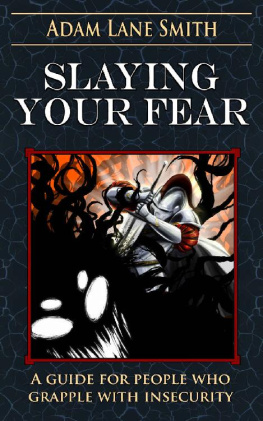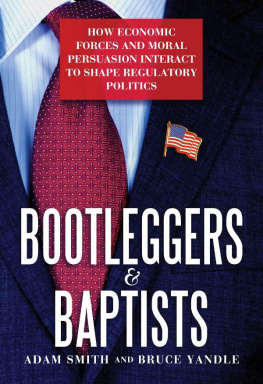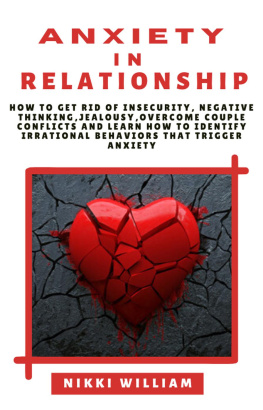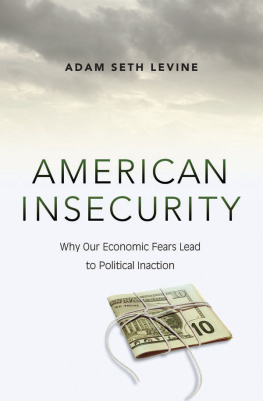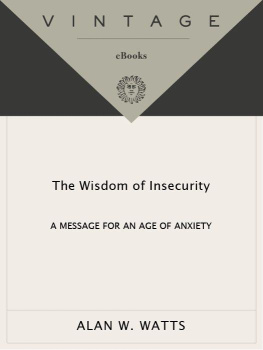Contents
Slaying Your Fear
A guide for people who grapple with insecurity
Adam Lane Smith, LMFT
Copyright 2019 by Adam Lane Smith
All rights reserved. No part of this publication may be reproduced, distributed, or transmitted in any form or by any means, including photocopying, recording, or other electronic or mechanical methods, without the prior written permission of the author, except in the case of brief quotations embedded in critical reviews and certain other noncommercial uses permitted by copyright law. Any questions can be sent to the author at .
The contents of this book do not guarantee success in marriage or any other relationship, should not be used to diagnose disorders, and are not intended to replace traditional mental health treatment. If you believe you are experiencing a mental health issue, please seek professi onal help.
This book contains sections which are works of fiction. Names, characters, businesses, places, events and incidents are either the products of the authors imagination or used in a fictitious manner. Any resemblance to actual persons, living or dead, fictional persons, or actual or fictional events is purely coi ncidental.
Cover design by Ashion.
Formatting by Kevin G . Summers.
Proofreading by Jeff Hasz.
Dedication
To the many dear friends who have approached me with their secret insecurities. May this book answer your questions better than my fumbling on-the-spot attempts.
Acknowledgements
This book represents the culmination of years of study and experience and would not be possible without many edifying encounters throughout my lifetime. The author would like to thank the many people whove contributed to his education, both formally and informally.
Cynthia Borges-ODell and Dr. Kenneth Huntley, who mentored me through graduate school and shaped me in my earliest days as a clinician. I would not know half of what I do now without your extensive tutelage and enormous support. Thank you for forging me in the fires of wisdom and preparing me for the work ahead.
Jesse Ellis, Laura Novitsky, Jennifer Czischke, and Jennifer Fritz, my licensure supervisors. Each of you were so incredibly different and gave me a wealth of experience from which to draw. I am indebted to each of you for your hours of patience and guidance.
And the many clients I have worked with over the years, who trusted me to assist them in rebuilding their lives and finding solutions in the darkest of times. It is the dearest wish of my heart that I served you well.
Slaying Your Fear
A guide for people who grapple with insecurity
My friends only pretend to like me.
Im sitting in my office on a Tuesday afternoon and talking with a client. Shes a young woman dressed in business casual on her lunch break from work, but Ive heard these words from hundreds of other clients. They may be male or female, old or young, black or white or polka-dot. The one constant is that theyre consumed with crippling insecurity and cant imagine deserving to be loved.
What makes you think theyre pretending? I ask.
She sighs. I dont know. Im just such a burden. How could they not hate me?
Have they ever given you reason to believe that? Said something? Thrown a brick at you?
The joke does the trick and she laughs, but its only half-hearted. Her self-loathing is weighing her down today. No. Theyre too nice to do that. Its just a feeling I have.
Have you ever tested it?
She shoots me a look that tells me my question sounded stupid.
Okay, I press, so how do you know?
The client looks confused, but quickly settles back into resignation. I just do. How could anyone really like me? Theres nothing about me to like.
Who I am and why I wrote this book
Insecurity is one of the most difficult internal challenges a person will face.
Humans are designed to flourish with love and acceptance. When a person fundamentally believes they are unlovable and will never be truly accepted, they begin to wither like a plant starving without sunlight. And when a person becomes so consumed with insecurity that they dont even trust themselves to find a way out of the pit of misery, a professional is often needed to help make things right again.
My name is Adam Lane Smith and Im an LMFT, a Licensed Marriage and Family Therapist. I have a masters degree in Psychology, have apprenticed under 5 separate clinicians with a range of different licenses, and have been practicing individual, family, and couples therapy for years in both correctional and clinical settings.
My job is to help individuals struggling with mental health issues. Some who come in are facing simple life challenges and need encouragement and skills to get through the temporary discomfort. Others, however, are grappling with a lifelong battle against themselves. Theyve felt alone most of their lives and cant imagine the warmth of human acceptance. Often, this intense separation from others has left them vulnerable to a host of mental health disorders. The specific issues I see related to insecurity cover a wide range of challenges including:
- Anxiety where everything related to relationships causes the person intense fear. They are so consumed with terror about making a mistake that they wake up fearful and spend their entire day wrapped in a cloud of worry.
- Depression from a lifetime of worrying and eventual surrender to the realization that worrying does nothing to stop their pain. Nothing helps, and they succumb to learned helplessness.
- Post-traumatic Stress Disorder from a seemingly uncomplicated event which impacted the client much deeper due to their emotional isolation and latent fear.
- Relationship issues where the couple is at odds over seemingly insignificant issues, but underneath the veneer of love is a mess of terror and insecurity.
Despite the range of issues facing individuals who come in for therapy, one problem has repeatedly presented itself in my office: People who are fundamentally convinced they cannot be loved and will be abandoned for the slightest mistake. For these individuals, every day is another gauntlet of events designed to cause them to stumble and reveal the horrifying secret of just how awful they really are. Everyone they love will gasp with shock, which will quickly turn to disgust. Word will spread to everyone who ever knew the insecure individual, and by the end of the day they will be a social pariah, living under a bridge with only flea-bitten coyotes for companions.
Time and again I encounter individuals with this exact issue, and its become prevalent enough that a recognizable pattern has emerged. People with early childhood struggles which impact their attachment style rarely seem to recover on their own. Instead, their lives seem to follow a trajectory passing through anxiety into depression, and possibly later into panic attacks, trauma, or other mental health issues.
Even older people in their sixties and seventies are sometimes afflicted by this pattern of behavior. Clients as young as 12 report the same issues, and parents I treat tell me they recognize some of the behaviors in their own tiny children at home. And once we dig into the past history of behavior, a few shared features usually come to light:
- Insecure individuals dont know how to explicitly ask others for what they want.
- When directed to state clearly what they want from others, insecure individuals experience a surge of anxiety which stops them.
- Insecure individuals suffer from low self-esteem but cant say why. They describe themselves as human garbage but can never state a compelling reason.
- Social situations are often terrifying for insecure individuals. It may seem bizarre to some that the closer they get to others, the greater the fear they experience because the stakes become so much higher.
Next page
